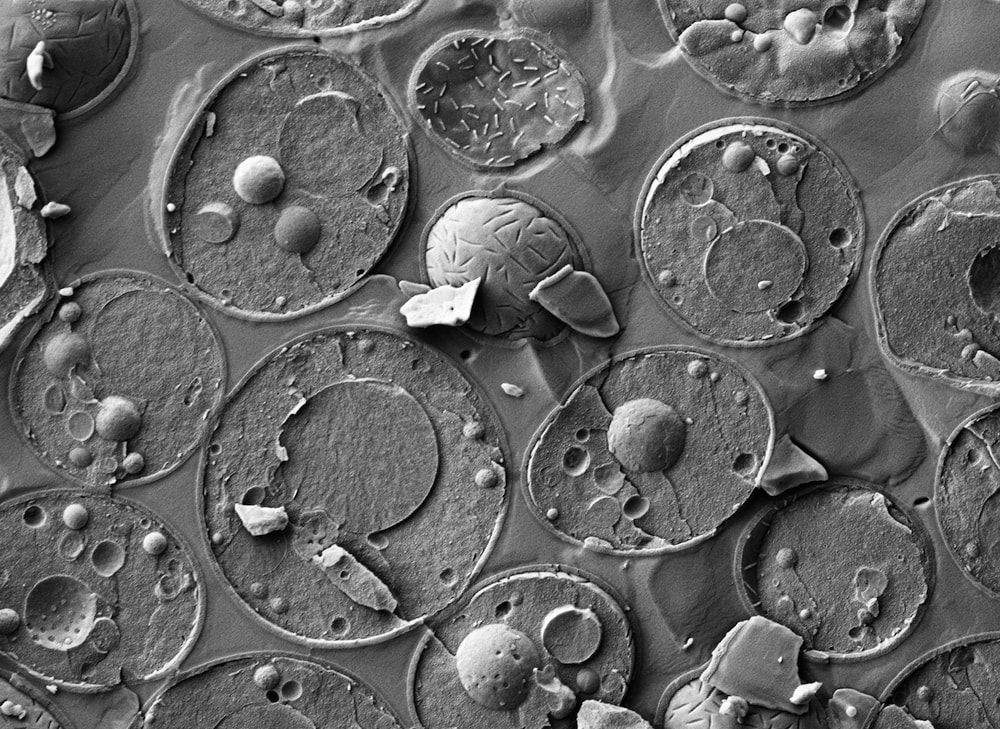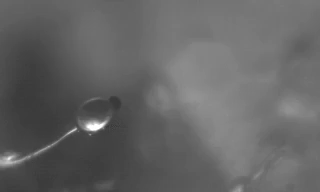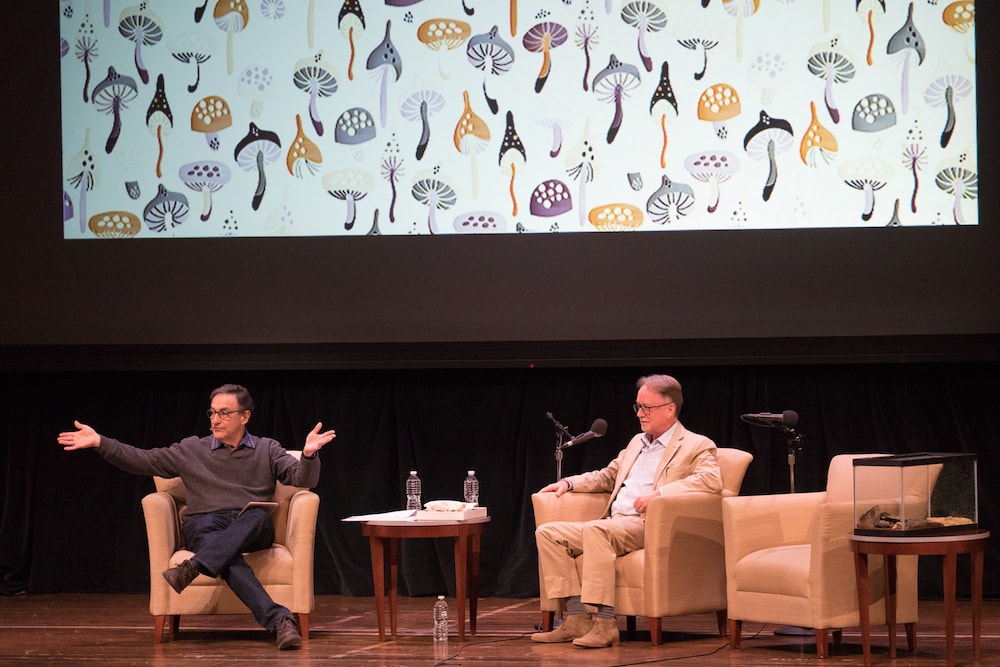The Yeast Also Rises
11:56 minutes

Yeast helps your bread to rise and beer to brew, but did you know that there’s yeast in the guts of insects? Or that your body is covered—and filled—with yeast cells? In this segment, recorded live in Miami University’s Hall Auditorium in Oxford, Ohio, mycologist Nicholas Money helps Ira uncover the hidden world of the humble fungus. His new book “The Rise Of Yeast” details some of the ways that the ubiquitous microorganism has helped shape civilization, from baking to biotechnology.
[It’s never too early to encourage a budding young scientist.]


Nicholas Money is the author of The Rise of Yeast: How the Sugar Fungus Shaped Civilization. He’s also a professor of botany at Miami University in Oxford, Ohio.
IRA FLATOW: This is Science Friday. I’m Ira Flatow coming to you from Miami University’s Hall Auditorium in Oxford, Ohio.
[APPLAUSE AND CHEERING]
I think we can all agree that human civilization is pretty complicated. There are different elements that made us the complex creatures we are today. Some might say fire, it allowed early humans to set up camp, or language helped us develop large groups. My next guest says there’s another driver of civilization, yeast. You heard me right, yeast. The simple fungus that you bake with. He’s here to unlock the mysteries of yeast and what it’s done for us. Nicholas Money is the author of the new book, The Rise of Yeast–
[LAUGHTER]
How the Sugar Fungus Shaped Civilization. He’s also Professor of Botany at Miami University in Oxford. Welcome to Science Friday.
NICHOLAS MONEY: Thank you for having me.
IRA FLATOW: You’re a mycologist, right? That’s somebody who studies mushrooms?
NICHOLAS MONEY: Mushrooms and other fungi, that’s right.
IRA FLATOW: What is yeast? Is it plant, is it animal, what is it?
NICHOLAS MONEY: So there are about 1,500 different species of yeast. And these are single-celled fungi that reproduce by forming buds. And so they’re structurally simple examples of other fungi, things that produce mushrooms, much more complicated structurally. But yeast is a surprisingly complicated thing in its own right.
One thing I find interesting culturally, is that mycologists like me that study fungal biology don’t tend to know much about yeast. And similarly, yeast biologists rarely refer to themselves as mycologists. They would say that they’re cell biologists that happen to use yeast as a model system in their experiments. But they would rarely regard themselves as mycologists, people interested in going out into the woods and finding mushrooms.
IRA FLATOW: So you guys are sort of separated. You study how mushrooms transport their spores. And we have some video clips. And I want you to explain what’s going on in this video clip here.
NICHOLAS MONEY: So this fungus here is a fungus called Pilobolus that grows on the dung of herbivores. And it shoots this packet of spores, that black thing that you see at the tip of this filament contains tens of thousands of microscopic spores. And these beautiful organisms, gorgeous thing, fires its spores into the air, its mechanism of dispersal.
And it’s shooting that mass into the air about 30 miles an hour, but the acceleration is astonishing. The acceleration is tens of thousands of G, because this thing’s going from a standing start to going pa-ching literally, in millionths of a second. And so what we’ve done here at Miami University is to use high speed cameras to actually capture these beautiful movements. They’re fantastically interesting scientifically, but they have an artistic beauty also.
IRA FLATOW: Is the mushroom the flowering part of the plant of what we’re talking about?
NICHOLAS MONEY: So there are no flowers that are produced by mushrooms and other fungi. They’re not related to plants closely at all. They’re much more closely related to animals, including us, than they are to plants. There’s no flower, but it’s a reproductive structure.
IRA FLATOW: So let’s talk about the yeast. We were talking about yeast tonight. How does yeast get around? Is it in the air all around us?
NICHOLAS MONEY: So that’s a good question. So with hundreds of different species of yeast, some of them are in the air a lot of the time. And in fact, they’re actually an important cause of asthma, particularly childhood asthma. They’re throwing up megatons of these spores into the atmosphere every year. And we’re inhaling them. We’re inhaling them right now in this room, undoubtedly.
But the particular yeast that we use for baking and brewing, it’s a bit paradoxical, we don’t know how it gets around. It gets around on us. And then we carry it in the things that we use in breweries and in vineyards, but it never gets airborne. I shouldn’t say that. It gets airborne within the guts of insects, things like wasps and hornets will carry it around. So that’s what’s happening in nature, the insects are carrying brewer’s yeast around.
IRA FLATOW: I know that this part of Ohio played a big part in how we use yeast today. Charles Fleischmann, right?
NICHOLAS MONEY: Absolutely.
IRA FLATOW: Is he the creator of the dry little yeast packet that’s named after him, started in Cincinnati?
NICHOLAS MONEY: That’s right. So the first commercial yeast plant in the United States was established in the community called Riverside that’s now incorporated into the City of Cincinnati. And Charles Fleischmann and his brother were Jewish immigrants from Austria. They arrived at the end of the Civil War here. And they imported a processes for making compressed yeast cakes that were– at that point, this was some big business in Europe.
But bread in America was really awful until the Fleishmanns introduced this practice. It was lumpy and it didn’t rise properly. And so the Fleishmanns just revolutionized baking in this country. And if you drive along River Road in Cincinnati today, there’s a place and you’ll see it, it’s Riverside Park. It’s a ballpark. There needs to be a historical marker there. This is the birthplace of American biotechnology. And there’s no marker there at all. I bet you could still find traces of yeast in the soil.
IRA FLATOW: It’s interesting how you put the word “knead” in when we talk about yeast.
[LAUGHTER]
NICHOLAS MONEY: Cincinnati also a sense for brewing in America, right?
IRA FLATOW: Is it the same yeast? Is it the same yeast in beer that’s in the bread?
NICHOLAS MONEY: It probably is actually, in terms of the one that Fleishmann used. They probably took yeast that was being used in the local breweries. So breweries like Christian Moerlein’s Brewery was established in the 1850s. And still brewing wonderful beer today. But so yes, it’s what we regard as the same species anyways.
IRA FLATOW: So the yeast has to be alive then, for it to do its job. And how does it stay alive on a shelf like that, in those little packets?
NICHOLAS MONEY: Well, it’s in freeze dried form, so it’s life in very, very slow mo. So most of the water content’s being removed. So it’s in suspended animation, if you like, sitting there on the grocery store shelves until we add water, and then this seemingly miraculous thing– it is miraculous, isn’t it– comes to a level at the top of this–
IRA FLATOW: You really love your yeast, don’t you?
NICHOLAS MONEY: I do. I’ve grown to love yeast. And we don’t have a great deal of choice about that since right now every person in this room is teeming with yeast cells on our surface and inside us.
IRA FLATOW: Yes, right up there in the balcony. Welcome.
AUDIENCE: Hi. My husband has some sourdough starter from 1885 that we’ve been making bread with all these years. He got it from his father, who got it from a guy, whose grandfather started it–
[LAUGHTER]
— he started it at a Montana lumber camp where he was a cook. And I was just wondering, is the yeast that’s in the sourdough, would that still be the original yeast from 1885?
NICHOLAS MONEY: That’s a great question. So some of the sourdough bakeries in San Francisco, so Boudin for example, they’ve been baking bread since the gold rush. And they actually claim that it’s the same strains of yeast and bacteria that are in their sourdough starter that they were using back late 19th century. But unless you’re actually keeping some stock in a cold state, mutation is occurring, so it’s changing genetically over time. But clearly the stuff still works.
I’ve heard lots of stories of people that do maintain these sourdough starters for years. It’s a different yeast though. The one that we use in general, for baking and brewing is a thing called saccharomyces, the sugar fungus. But the sourdough yeast is different. It’s a species of thing called Candida. But the important point about sourdough breads is that they have bacteria, species of lactobacillus that are actually responsible for acidifying and giving that sour taste to the bread.
IRA FLATOW: You say that yeast is more complex than the sun? Tell us what intrigues you about– how does it work like the cell wall, for example?
NICHOLAS MONEY: So this picture here, it’s an electron micrograph. It’s a very high powered view of the interior of yeast cells. And what you’re seeing there is indeed, each of the cells has got a wall around it. But otherwise, if you look inside the cell, there’s all of the same components in that yeast cell that we find in our own cells. And that’s really what makes saccharomyces such a brilliantly interesting thing biologically is we can use this as a model for actually studying the way that we work.
And there have been some fascinating experiments in which– so we’ve got 46 chromosomes, yeast has got 16. And scientists have been actually replacing some of– they’ve got six of yeast chromosomes right now of being replaced with synthetic versions of those chromosomes that seem to work very well. And this is seen as a fantastically useful tool in biomedical research.
IRA FLATOW: Do you have a favorite yeast that?
NICHOLAS MONEY: My favorite yeast is one that probably– this is getting a little bit esoteric–
IRA FLATOW: We like that. We like that.
NICHOLAS MONEY: — is a thing called dipedesis, because when I was–
IRA FLATOW: I could’ve guessed that one.
NICHOLAS MONEY: — there’s many people. Maybe I should start there– anyway, I fell in love with this yeast at the age of 18, 19 when I went to university in Britain. And a professor said, you should work on this, and I did and it was marvelous. It was like being Charles Darwin offered a berth on the Beagle. I was going to get to study this yeast as a teenager. And you know, I’ve never–
IRA FLATOW: I never heard before, somebody– No, I’m serious. I’m marveling at your interest, how you could know at such a young age that yeast fascinated you.
NICHOLAS MONEY: It shows the power of a good professor, doesn’t it? This guy, he sold this to me.
IRA FLATOW: If you had an unlimited check, I have right here in my pocket, a blank check, and I’m going to give– well, I don’t have it, but I’m going to say I did, I know you’re disappointed– what would you do? What research should we be going?
NICHOLAS MONEY: So that’s a really good question. I think that it would be very, very interesting to focus on research and we’re actually physically manipulating yeast. There’s a lot of work that was done some years ago and actually, sort of hands on experiments on yeast, manipulating yeast cells, seeing the way that they respond, making measurements of the activity of the chemistry of their membranes, and so forth. And we do live in an age right now where the focus is on the genome of yeast. And I think getting back to some of that very basic cell biological work and I think that would be a very interesting way of spending a great deal of money.
IRA FLATOW: Thank you very much. Nicholas Money, author of the new book, The Rise of Yeast, How the Sugar Fungus Shaped Civilization. He’s also a professor of botany right here in Miami University in Oxford, Ohio.
[APPLAUSE]
After the break, feel like this winter dragged on forever? We meet some animals that have adapted to tolerate harsh temperatures, some even freeze solid.
Copyright © 2018 Science Friday Initiative. All rights reserved. Science Friday transcripts are produced on a tight deadline by 3Play Media. Fidelity to the original aired/published audio or video file might vary, and text might be updated or amended in the future. For the authoritative record of Science Friday’s programming, please visit the original aired/published recording. For terms of use and more information, visit our policies pages at http://www.sciencefriday.com/about/policies/
Alexa Lim was a senior producer for Science Friday. Her favorite stories involve space, sound, and strange animal discoveries.
As Science Friday’s director and senior producer, Charles Bergquist channels the chaos of a live production studio into something sounding like a radio program. Favorite topics include planetary sciences, chemistry, materials, and shiny things with blinking lights.